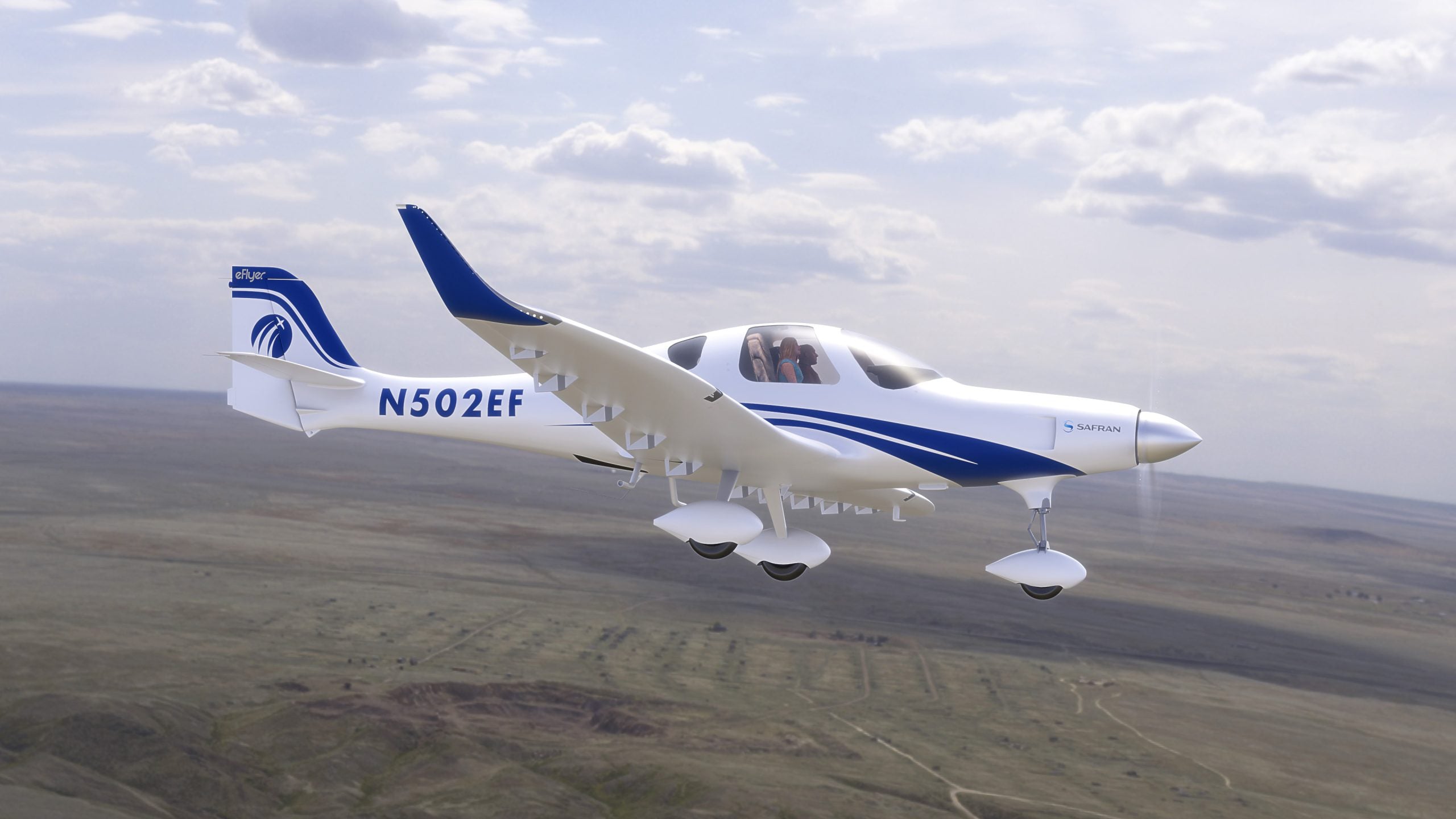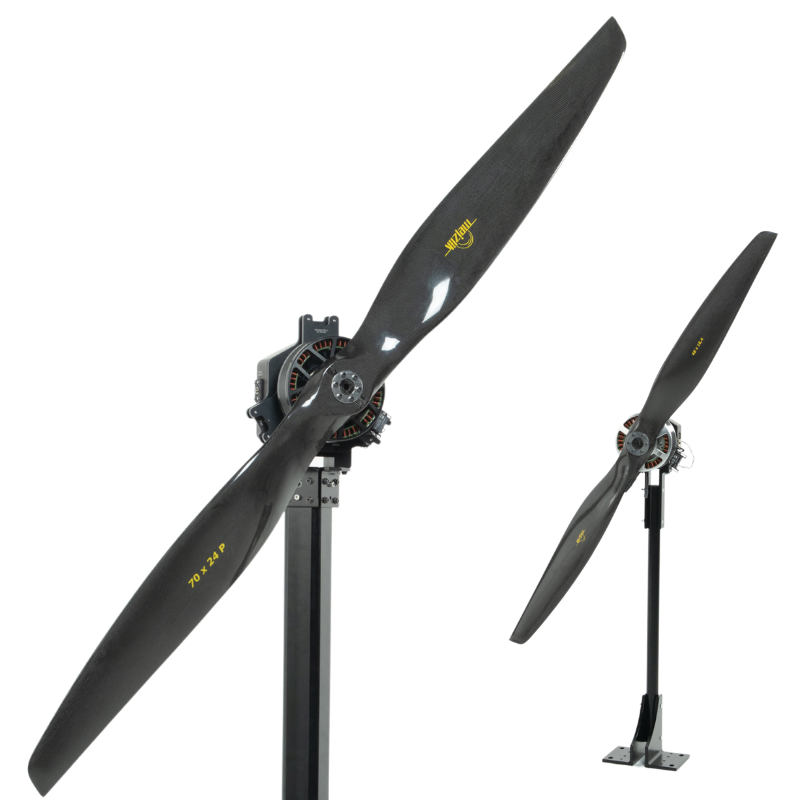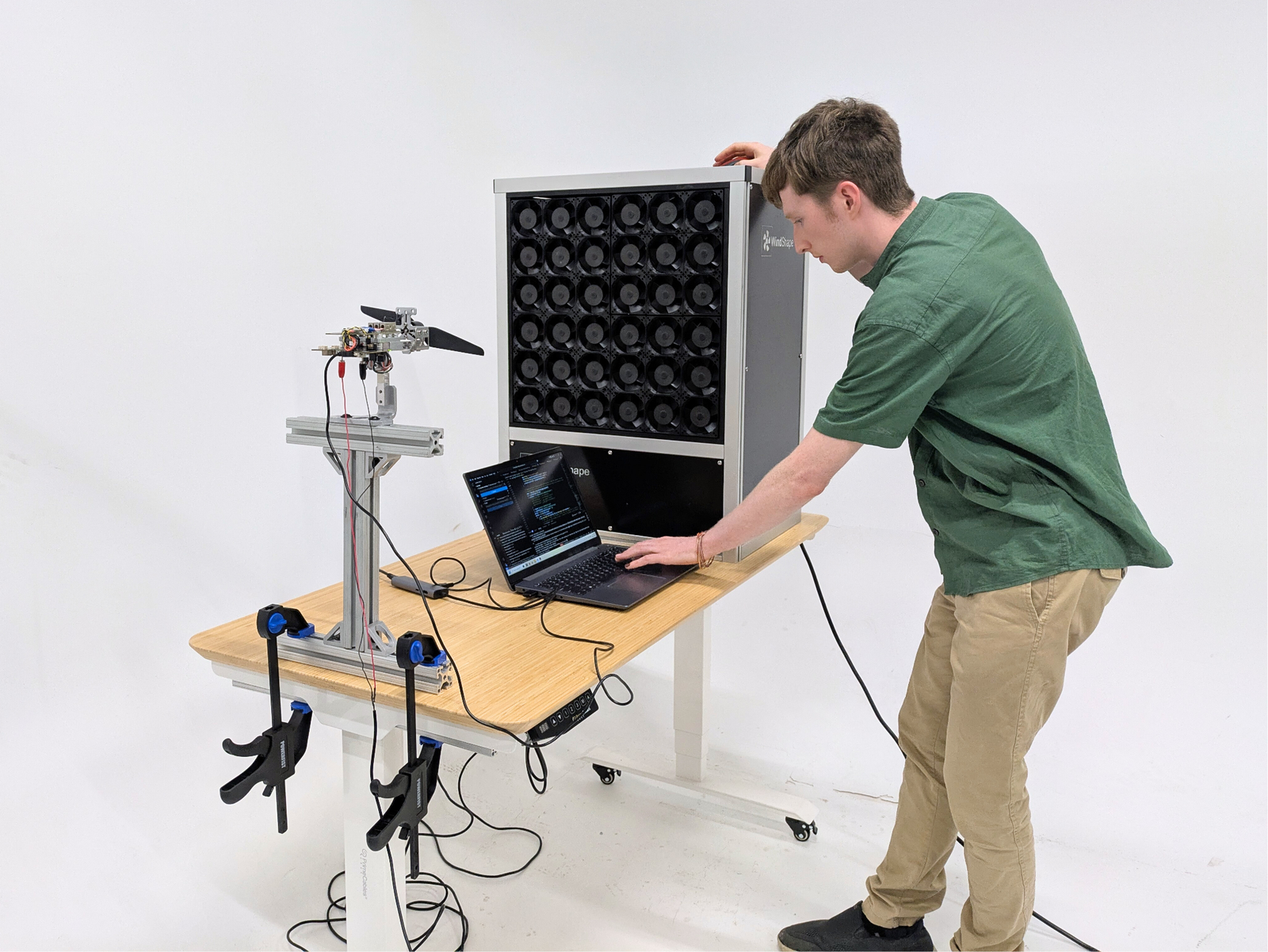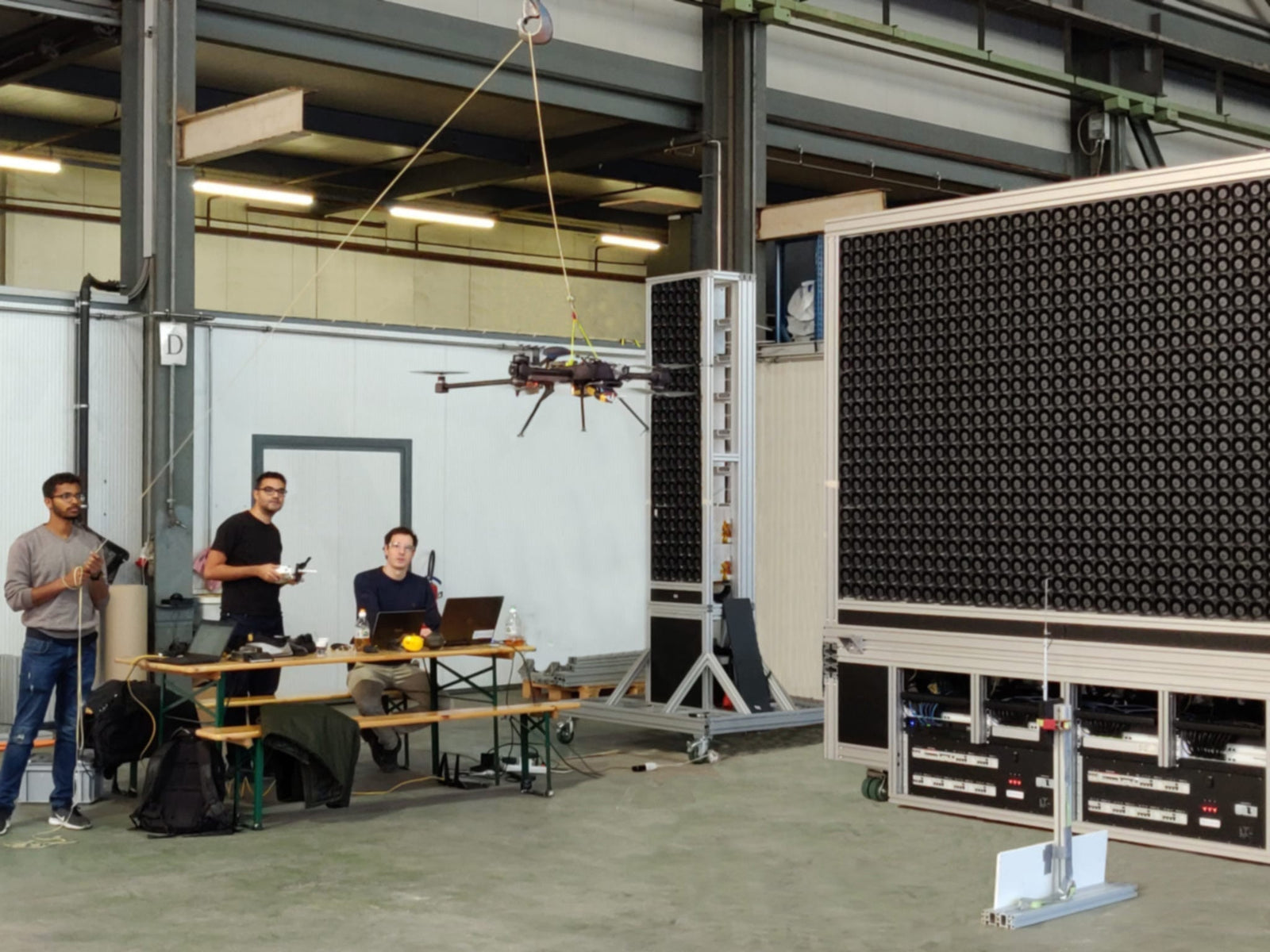By Lauren Nagel
If you're looking for big and powerful drone motors, look no further.
In this article we are focusing on big and powerful brushless motors that have at least 9 kW of power. These are motors for heavy lift drones, eVTOL, electric airplanes, and more.
Skip to the end to see the performance summary table.
In this article we will provide an in-depth comparison of these motor brands:
| • magniX |
• H3X
|
|
• EMRAX
|
|
|
• Safran
|
|
|
• T-Motor
|
• Turnigy
|
|
• Thin Gap
|
• KDE Direct |
| • Plettenberg | |
| • Geiger Engineering |
Need to test large motors and propellers? Check out our Flight Stand 150 (150 kgf/ 150 Nm) and Flight Stand 500 (500 kgf/ 1500 Nm) test stands:

magniX
magniX has become a household name for those following the development of the commercial electric aircraft industry. Through several fruitful partnerships, magniX motors have powered some of the most promising electric aircraft ever tested, including Harbour Air’s electric Beaver seaplane as well as the largest fully electric commercial aircraft to date, the Cessna eCaravan. Noting that in 2019 over 45% of commercial flights were less than 500 NM, magniX hopes to electrify these routes for improved environmental sustainability. Currently magniX lists two electric propulsion units on their website, the specs for the magni650 EPU are below.
Specifications:
- Max power: 640 kW
- Continuous torque: 3,200 Nm
- Max speed: 2,300 RPM
- Weight: 220 kg
- Known for: proven success in airworthy electric airplanes and seaplanes
- Location: Everett, USA
- Website:www.magnix.aero/
 Figure 1: Electric Beaver seaplane by magniX and Harbour Air (Photo from Harbour Air)
Figure 1: Electric Beaver seaplane by magniX and Harbour Air (Photo from Harbour Air)
H3X
A new and ambitious player on the scene, H3X is a US-based company with aims to power large commercial aircraft like the Boeing 737. Their unique design combines the electric motor, inverter, and gearbox into a single unit. They currently have one model ready to order, the HPDM-30, with two larger models available for pre-order. Below are the performance characteristics for the HPDM-30:
Specifications:
- Max power: 41 kW
- Max torque: 19.6 Nm
- Max speed: 20,000 RPM
- Weight: 4.1 kg
- Known for: superior power density
- Location: Minneapolis, USA
- Website: www.h3x.tech/
Further reading: Automated Tests for Your BLDC Motor
EMRAX
The idea for EMRAX was born in 2005 when founder Roman Susnik flew Slovenia’s first flight in an electric aircraft. The flight ended in an emergency landing when the aircraft’s brushless motor failed, inspiring Susnik to develop a suitable motor himself. By 2008 a functional prototype was created and tested, and EMRAX had several requests for collaborations. Now in 2020, EMRAX engines are already used in a variety of electric gliders and aircraft. The motors possess a high power density and air-cooling, making them ideal for aviation applications. The performance figures for their largest model, the EMRAX 348, are summarized below.
Specifications:
- Max power: 400 kW
- Max torque: 1000 Nm
- Max speed: 4,500 RPM
- Max voltage: 800 V
- Peak efficiency: 96%
- Weight range: 43.9 kg
- Known for: high power density and stacking option
- Location: Kamnik, Slovenia
- Website: emrax.com/
MGM COMPRO / Rotex
Based in Czechia, MGM COMPRO and Rotex collaborate to bring advanced motor-ESC systems to the electric aviation market. They are involved in many innovative projects including eVTOL vehicles, tilt-rotor aircraft, and personal flying machines. Already on the market are the VELO self-launching gliders developed in partnership with GP Gliders and the ΦNIX all-electric plane by the Pure Flight consortium. Here are the specs for their largest off-the-shelf motor, the REB 90:
Specifications:
- Max power: 80 kW
- Max torque: 300 Nm
- Max speed: 4,000 RPM
- Max voltage: 800 V
- Peak efficiency: Up to 99%
- Weight range: 23.8 kg
- Known for: tailor-made, unique technical solutions
- Location: Zlin, Czechia
- Website:www.mgm-compro.com/
- Website: https://www.rotexelectric.eu/

Figure 2: VELO glider by MGM COMPRO and GP Gliders (Photo from MGM Compro)
NeuMotors
NeuMotors manufactures both inrunner and outrunner brushless motors. They have been active since 2002. Their largest motors are their 180xx series, whose specs are below.
Specifications:
- Max power: 80 kW
- Max torque: --
- Max speed: 8,000 RPM
- Voltage range: --
- Peak efficiency: --
- Weight: 8 kg+
- Known for: inrunners and outrunners
- Location: San Diego, USA
- Website: https://neumotors.com/
Safran
With a strong electrical engineering portfolio, it is no surprise that Safran has developed their own brushless motors for use in the aviation industry. Called ENGINeUS, the line of smart motors boast some unique features, such as motor controller integration and a sealed design for use in harsh environments. The ENGINeUS is already used in Bye Aerospace's eFlyer, and Safran has announced that they now have hybrid motors available for commuter-sized aircraft. The performance characteristics for the largest fully electric ENGINeUS motor are outlined below.
Specifications:
- Max power: 1 MW
- Max torque: --
- Max speed: 3,500 RPM
- Max voltage: 850 V
- Peak efficiency: --
- Weight: --
- Known for: tolerance of harsh environments, integrated motor controller
- Location: Paris, France (headquarters)
- Website:www.safran-electrical-power.com/

T-Motor
T-Motor remains a drone-focused company, but their high-powered brushless motors are suitable for much more than quadcopters. Their U15L, XL and XXL models in particular are highly relevant for the manned aviation industry, producing up to 98 kg of thrust per motor. While no manned applications are advertised to date, theirYouTube channel highlights some of the larger UAVs and eVTOL vehicles that their motors can power. Below are the performance specs of their U15XXL motor:
Specifications:
- Max power: 28 kW
- Max torque:
- Max speed: --
- Voltage: 100 V
- Peak efficiency: --
- Weight: 5.2 kg
- Known for: climate versatility, all-around performance
- Location: Nanchang, China
- Website:uav-en.tmotor.com/
Turnigy
Having been around for over 20 years, Turnigy takes pride in keeping prices low for consumers through their ‘slick’ supply chain. They offer nine main models of motors, each suited to a unique function. While they are focused on the drone and RC industries, their motors offer sufficient power for certain manned flights, such as manned multicopters and paramotors. They also offer their own pre-made mini paramotor. Below are the specs for Turnigy's largest motor available on Hobby King's website:
Specifications:
- Max power: 9.8 kW
- Max torque: --
- Max speed:
- Max voltage: 52 V
- Peak efficiency: --
- Weight: 2.53 kg
- Known for: motors for a variety of uses
- Location: sold through Hobby King (Hong Kong, China)
- Website:www.turnigy.com/
Thin Gap
Designed with both civilian and military uses in mind, Thin Gap motors are known for their toughness and high torque: weight ratio. They also prides themselves on their proprietary ironless stator and no cogging design, which allows for high power density, smoothness and efficiency. Looking to break into the VTOL industry, Thin Gap partnered with Aurora Flight Sciences to develop a powerful fan system for lifting heavy unmanned vehicles. The research contributed to the design of the Aurora LightningStrike XV-24A, an electric Osprey-like project that has been discontinued. Below are the performance specs for their LSI 267-58 motor.
Specifications:
- Max power: 44 kW
- Max torque: 191 Nm
- Max speed: 2,200 RPM
- Voltage: > 726 V
- Peak efficiency: --
- Weight: 4 kg
- Known for: ironless stator and no cogging design, high torque: weight ratio
- Location: Camarillo, USA
- Website:www.thingap.com/

Figure 4: Thin Gap motor kit (image from Thin Gap website)
KDE Direct
KDE Direct approaches manufacturing with the mission to power future-focused applications such as flights, satellites and space exploration. Their brushless motors are designed for longevity and zero-vibration operation, ideal for smooth flights and missions. While they are largely used in drones and UAVs, they also offer sufficient power to lift heavy lift drones. The performance range for KDE Direct’s brushless motor fleet is outlined below.
Specifications:
- Max continuous power range: 0.43 - 12.8 kW
- Max torque range: --
- Max speed range: --
- Voltage range: 60.9 V
- Peak efficiency: --
- Weight range: 2.1 kg
- Known for: zero vibration operation
- Location: Bend, USA
- Website:www.kdedirect.com/
Further reading: Why You Should Measure Your Brushless Motor's Torque
Pipistrel
Pipistrel is a leader in the electrical propulsion industry, with several different models of fully-electric aircraft available for purchase. Their Velis Electro aircraft was the first ever electric-powered aeroplane to receive a type certificate from the EASA, paving the way for the development of the industry. They also offer electric self-launching gliders and hybrid general aviation style aircraft. Powering these aircraft is their E-811 liquid-cooled engine, capable of 49.2 kW of continuous power. Here’s a full summary of its basic characteristics.
Specifications:
- Max power: 57.6 kW
- Max torque: 220 Nm
- Max speed: 2,500 RPM
- Max voltage: 400 V
- Peak efficiency: --
- Weight: 22.7 kg
- Known for: the first electric engine certified for general aviation use by the EASA
- Location: Ajdovščina, Slovenia
- Website:www.pipistrel-aircraft.com/

Figure 5: The fully electric Velis Electro Aircraft (Photo from Pipistrel)
MAD Components
The brushless motors created by MAD Components were "born for" heavy lift and manned drones, to put it in their words. Each rotor equipped with a MAD Components motor is designed to offer a maximum thrust of up to 114 kgf per rotor. Designed for both commercial and recreational uses, you will see MAD motors in aircraft ranging from emergency rescue drones to paragliders. Below are the specs for their top performing motor, the MAD TORQ M50C35 PRO EEE 34 KV.
Specifications:
- Max power: 25 kW
- Max torque: up to 78.4 Nm
- Max speed: --
- Max voltage: --
- Peak efficiency: 87%
- Weight: up to 4.2 kg
- Known for: optimized cooling design, sturdy components
- Location: Warsaw, Poland
- Website: https://mad-motor.com/
ePropelled
ePropelled is determined to shake up the brushless motor industry for eVTOL and aviation by developing solutions that meet the power-to-weight ratio needs of the trade. Their mandate specifically mentions the delivery of “propulsion systems for unmanned aerial vehicles (UAVs) and electric vertical takeoff and landing aircraft (eVTOL).” Their patented technology “produces a dramatically more energy-efficient method of electric propulsion that increases flight range and life expectancy of the battery pack”, allowing the manufacturer to save money on battery costs. Below are the specs for their LEV 8000 motor.
Specifications:
- Max power: up to 8 kW
- Max torque: up to 70 Nm
- Max speed: 7,500 RPM
- Max voltage: --
- Peak efficiency: 90%
- Dimension (DxL) - 220 mm x 223.5 mm
- Known for: --
- Location: Lowell, USA
- Website:https://epropelled.com/
Fly Dragon
Fly Dragon is a Chinese company operating in Chengdu. They offer three motors for heavy lift drones, the largest of which is the G110. All of their heavy lift motors come as a kit that includes a propeller and ESC. The specs for their G100 motor operating at 500 V and 80% throttle are below.
Specifications:
- Max power: 54 kW
- Max torque: 108 Nm
- Max speed: 2,670 RPM
- Max voltage: 650 V
- Peak efficiency: >88%
- Weight: 13.2 kg
- Known for: motors for heavy lift drones
- Location: Chengdu, China
- Website: http://www.dronefromchina.com/

Figure 6: G110 propulsion kit from Fly Dragon (photo from Fly Dragon website)
Plettenberg
Plettenberg’s guiding principle is to achieve maximum efficiency at the lowest possible weight. They have several off the shelf electric motors available for purchase and they also do custom projects on request. According to their website, their standard solutions “offer efficiency levels of up to 95 % and power-to-weight ratios of up to 26 kW/kg.” Their Nova 50 motor is the most powerful in their fleet, full specs below.
- Max power: 50 kW
- Max torque: 142 Nm
- Max speed: 5,600 RPM
- Max voltage: 320 V
- Peak efficiency: >93%
- Weight: 11.5 kg
- Known for: High efficiency motors
- Location: Baunatal, Germany
- Website:https://plettenberg-motoren.net/
Further reading: How Brushless Motors Work and How to Test Them
Beyond Motors
Beyond Motors manufactures a range of axial flux motors for various applications including aviation, marine, automotive and racing. They use a 'patent pending' water cooling system that enables high efficiency and continuous power. Their range of motors starts at a continuous power of 75 kW and continues all the way up to 230 kW continuous with a 430 kW peak in their AXM4 motor. And for those who need it, their motors are designed to be stacked up to 3 in a row for triple power within the same diameter.
Specifications:
- Max power: 430 kW
- Continuous torque: 600 Nm
- Max speed: --
- Voltage: --
- Peak efficiency: --
- Weight: 48 kg
- Known for: their high continuous power: weight ratio.
- Website: https://www.beyondmotors.io
Geiger Engineering
Geiger Engineering manufactures electric motors, propellers, and accessories for aviation applications. What makes their motors unique is their Duplex option, which contains two identical power systems with homogenous redundancy to protect the aircraft in the event of one system failing. Below are the specs for the largest member of their High Power Direct (HPD) family of motors.
Specifications:
- Max power: 70 kW
- Continuous torque: --
- Max speed: 260 RPM
- Voltage: --
- Peak efficiency: --
- Weight: 16 kg
- Known for: Duplex system for extra security
- Website: https://www.geigerengineering.de/en

Free RC Hobby
The MP240150 is Free RC Hobby’s largest off the shelf motor. It offers customizable parameters for sensors, cooling, and Kv. From their website, their slogan is “we can do what you need"!
- Max power: 100 kW
- Max torque: up to 180 Nm
- Max speed: --
- Max voltage: 400 V
- Peak efficiency: --
- Weight: up to 19 kg
- Known for: --
- Location: Dongguan, China
Website:https://www.freerchobby.cc/
Summary table (from highest to lowest max power)



 Back to Blog
Back to Blog


Scott
May 26, 2025
I’m in the design process of a unique type of V.T.O.L. I would like to know the estimated cost of 3 pipistrel. I just looking for a quot at this time.